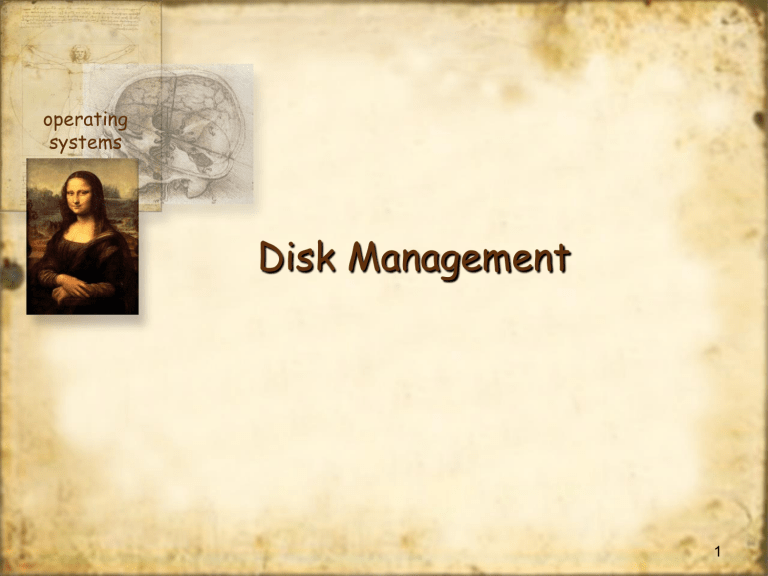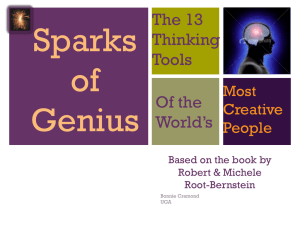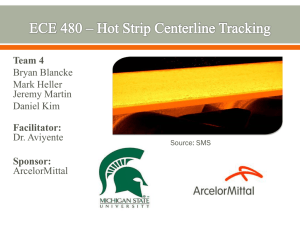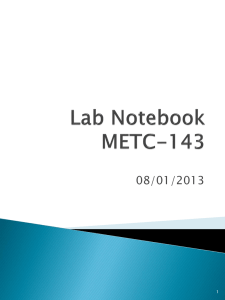Slide Set 10

operating systems
Disk Management
1
operating systems
Goals of I/O Software
Provide a common, abstract view of all devices to the application programmer (open, read, write)
Provide as much overlap as possible between the operation of I/O devices and the CPU.
2
operating systems
I/O – Processor Overlap
Application programmers expect serial execution semantics read (device, “%d”, x); y = f(x);
We expect that this statement will complete before the assignment is executed.
To accomplish this, the OS blocks the process until the I/O operation completes.
3
operating systems read(device, %D”, x); y = f(x);
…
READ User Process
Device Independent Layer
Device Dependent Layer
Interrupt Handler
Without Blocking!
The read has not and the value of x is updated.
execute.
CPU data status command
Device Controller x
4
operating systems app1
In a multi-programming environment, another application could use the cpu while the first application waits for the I/O to complete.
Request I/O operation
I/O
Complete app2 done app2
I/O controller
5
operating systems
Performance
Thread execution time can be broken into:
•Time
•Time
•Time compute device overhead
The time the thread spends doing computations
The time spent on I/O operations
The time spent determining if I/O is complete
So, Time total
= Time compute
+ Time device
+ Time overhead
6
operating systems
Performance
When the device driver polls
Time total
= Time compute
+ Time device
+ Time overhead
Time overhead
= The period of time between the point where the device completes the operation and the point where the polling loop determines that the operation is complete. This is generally just a few instruction times.
Note that when the device driver polls, no other process can use the cpu. Polling consumes the cpu.
7
Are you done yet?
8
operating systems
Performance
When the device driver uses interrupts
Time total
= Time compute
+ Time device
+ Time overhead
When the device driver uses interrupts
Time overhead
= Time handler
+ Time ready
Time
Time handler ready is the time spent in the interrupt handler is the time the process waits for the cpu after it has completed its I/O, while another process uses the CPU.
9
operating systems process
For simplicity’s sake assume processes of the following form: Each process computes for a long while and then writes its results to a file.
We will ignore the time taken to do a context switch.
Time compute
Request an
I/O operation
Time compute
I/O controller
Time device
10
operating systems
Proc 1
Polling Case
Time overhead
Time compute
Time device
Time compute
Time compute
Proc 2
Time device
Time overhead
Time compute
In the polling case, the process starts the I/O operation, and then continually loops, asking the device if it is done.
11
Interrupt Case
operating systems
Time interrupt handler
Time overhead
Time device
Time compute Proc 1
Time compute
Time compute
Proc 2
In the interrupt case, the process starts the I/O operation, and then blocks. When the I/O is done, the os will get an interrupt.
Time device
12
Which gives better system throughput?
* Polling
* Interrupts
Which gives better application performance?
* Polling
* Interrupts
If you were developing an operating system, would you choose interrupts or polling?
13
operating systems
User space
Kernel
Buffering Issues
Read from the disk
Into user memory
Assume that you are using interrupts…
What problems Exist in this situation?
14
operating systems
User space
Kernel
Buffering Issues
Read from the disk
Into user memory
Assume that you are using interrupts…
What problems Exist in this situation?
The process cannot be completely swapped out of memory. At least the page containing the addresses into which the data is being written must remain in real memory.
15
operating systems
User space
Kernel
Buffering Issues
Read from the disk into kernel buffer.
When the buffer is full, transfer to memory in user space.
16
operating systems
User space
Kernel
Buffering Issues
We can now swap the user processor out
While the I/O completes.
What problems Exist in this situation?
1. The O/S has to carefully keep track of the assignment of system buffers to user processes.
2. There is a performance issue when the user process is not in memory and the O/S is ready to transfer its data to the user process. Also, the device must wait while data is being transferred.
3. The swapping logic is complicated when the swapping operation uses the same disk drive for paging that the data is being read from.
17
operating systems
User space
Kernel
Buffering Issues
Some of the performance issues can be addressed by double buffering. While one buffer is being transferred to the user process, the device is reading data into a second buffer.
18
operating systems
Networking may involve many copies
19
operating systems
Disk Scheduling
Because Disk I/O is so important, it is worth our time to investigate some of the issues involved in disk I/O.
One of the biggest issues is disk performance.
20
seek time is the time required for the read head to move to the track containing the data to be read.
21
rotational delay or latency, is the time required for the sector to move under the read head.
22
operating systems
Performance Parameters
Wait for device
Wait for
Channel seek rotational delay
(latency) data transfer
Device busy
Seek time is the time required to
Rotational delay is the time required for the data on
T t delay will be 8.3ms.
23
operating systems
Data Organization vs.
Performance
Consider a file where the data is stored as compactly as possible, in this case the file occupies all of the sectors on
8 adjacent tracks
(32 sectors x 8 tracks = 256 sectors total).
The time to read the first track will be average seek time rotational delay read 32 sectors
20 ms
8.3 ms
16.7 ms
45ms
Assuming that there is essentially no seek time on the remaining tracks, each successive track can be read in 8.3 + 16.7 ms = 25ms.
Total read time = 45ms + 7 * 25ms = 220ms = 0.22 seconds
24
operating systems
If the data is randomly distributed across the disk:
For each sector we have average seek time rotational delay read 1 sector
20 ms
8.3 ms
0.5 ms
28.8 ms
Total time = 256 sectors * 28.8 ms/sector = 7.73 seconds
Random placement of data can be a problem when multiple processes are accessing the same disk.
25
operating systems
In the previous example, the biggest factor on performance is ?
Seek time!
To improve performance, we need to reduce the average seek time.
26
Queue operating systems
Request
Request
Request
Request
…
If requests are scheduled in random order, then we would expect the disk tracks to be visited in a random order.
27
Queue operating systems
Request
Request
Request
Request
…
First-come, First-served
Scheduling
If there are few processes competing for the drive, we can hope for good performance.
•If there are a large number of processes competing for the drive, then performance approaches the random scheduling case.
28
operating systems
While at track 15, assume some random set of read requests -- tracks 4, 40, 11, 35, 7 and 14
Track
40
30
20
10
Head Path
15 to 4
4 to 40
40 to 11
11 to 35
35 to 7
7 to 14
Tracks Traveled
11 steps
36 steps
29 steps
24 steps
28 steps
7 steps
135 steps
Steps
50 100
29
operating systems
Queue
Request
Request
Request
Request
…
Shortest Seek Time First
Always select the request that requires the shortest seek time from the current position.
30
operating systems
While at track 15, assume some random set of read requests -- tracks 4, 40, 11, 35, 7 and 14
Track
Shortest Seek Time First
Head Path Tracks Traveled
40
30
20
10
Problem?
50
Steps
100
In a heavily loaded system, incoming requests with a shorter seek time will constantly push requests with long seek times to the end of the queue. This results in what is called “Starvation”.
31
Queue operating systems
Request
Request
Request
Request
…
The elevator algorithm
(scan-look)
Search for shortest seek time from the current position only in one direction.
Continue in this direction until all requests have been satisfied, then go the opposite direction.
In the scan algorithm, the head moves all the way to the first (or last) track with a request before it changes direction.
32
operating systems
40
30
20
10
While at track 15, assume some random set of read requests
Track 4, 40, 11, 35, 7 and 14. Head is moving towards higher numbered tracks.
Track
Scan-Look
Head Path Tracks Traveled
Steps
50 100
33
Which algorithm would you choose if you were implementing an operating system? Issues to consider when selecting a disk scheduling algorithm:
Performance is based on the number and types of requests.
What scheme is used to allocate unused disk blocks?
How and where are directories and i-nodes stored?
How does paging impact disk performance?
How does disk caching impact performance?
34
operating systems
Disk Cache
The disk cache holds a number of disk sectors in memory.
When an I/O request is made for a particular sector, the disk cache is checked. If the sector is in the cache, it is read. Otherwise, the sector is read into the cache.
35
operating systems
Replacement Strategies
Least Recently Used replace the sector that has been in the cache the longest, without being referenced.
Least Frequently Used replace the sector that has been used the least
36
RAID
Redundant Array of Independent Disks
• Push Performance
• Add reliability
37
operating systems strip 0 strip 1 strip 2 strip 3 strip 4 strip 5 strip 6 strip 7 strip 8 strip 9 strip 10 strip 11 o o o
Logical Disk
RAID Level 0: Striping
Disk Management
Software
Physical
Drive 1 strip 0 strip 2 strip 4 strip 6 o o o
Physical
Drive 2 strip 1 strip 3 strip 5 strip 7 o o o
A Stripe
38
operating systems strip 0 strip 1 strip 2 strip 3 strip 4 strip 5 strip 6 strip 7 strip 8 strip 9 strip 10 strip 11 o o o
RAID Level 1: Mirroring
High Reliability
Physical
Drive 1
Disk Management
Software
Physical
Drive 2
Physical
Drive 3
Logical Disk
Physical
Drive 4
39
operating systems strip 0 strip 1 strip 2 strip 3 strip 4 strip 5 strip 6 strip 7 strip 8 strip 9 strip 10 strip 11 o o o
Logical Disk
RAID Level 3: Parity
High Throughput
Physical
Drive 1
Physical
Drive 2
Physical
Drive 3
Physical
Drive 4
Disk Management
Software parity
40
Thinking About What You
Have Learned
41
operating systems
Suppose that 3 processes, p1, p2, and p3 are attempting to concurrently use a machine with interrupt driven I/O. Assuming that no two processes can be using the cpu or the physical device at the same time, what is the minimum amount of time required to execute the three processes, given the following (ignore context switches):
Process
1
Time compute
Time device
10 50
2 30 10
3 15 35
42
Process
1
Time compute
Time device
10 50
2 30 10
3 15 35 p3
P1 p2
0 10 20 30 40 50 60 70 80 90 100 110 120 130
105
43
Consider the case where the device controller is double buffering I/O.
That is, while the process is reading a character from one buffer, the device is writing to the second.
What is the effect on the running time of the process if the process is
I/O bound and requests characters faster than the device can provide them?
The process reads from buffer A.
It tries to read from buffer B, but the device is still reading. The process blocks until the data has been stored in buffer B. The process wakes up and reads the data, then tries to read Buffer A.
Double buffering has not helped performance.
Process
A Device
Controller
B
44
Consider the case where the device controller is double buffering I/O.
That is, while the process is reading a character from one buffer, the device is writing to the second.
What is the effect on the running time of the process if the process is
Compute bound and requests characters much slower than the device can provide them?
The process reads from buffer A.
It then computes for a long time.
Meanwhile, buffer B is filled. When
The process asks for the data it is already there. The process does not have to wait and performance improves.
Process
A Device
Controller
B
45
Suppose that the read/write head is at track is at track 97, moving toward the highest numbered track on the disk, track 199. The disk request queue contains read/write requests for blocks on tracks
84, 155, 103, 96, and 197, respectively.
How many tracks must the head step across using a FCFS strategy?
46
Suppose that the read/write head is at track is at track 97, moving toward the highest numbered track on the disk, track 199. The disk request queue contains read/write requests for blocks on tracks
84, 155, 103, 96, and 197, respectively.
199
150
100
50
Track
How many tracks must the head step across using a FCFS strategy?
97 to 84
84 to 155
155 to 103
103 to 96
96 to 197
13 steps
71 steps
52 steps
7 steps
101 steps
244 steps
Steps
100 200 47
Suppose that the read/write head is at track is at track 97, moving toward the highest numbered track on the disk, track 199. The disk request queue contains read/write requests for blocks on tracks
84, 155, 103, 96, and 197, respectively.
How many tracks must the head step across using an elevator strategy?
48
Suppose that the read/write head is at track is at track 97, moving toward the highest numbered track on the disk, track 199. The disk request queue contains read/write requests for blocks on tracks
84, 155, 103, 96, and 197, respectively.
199
150
100
50
Track
How many tracks must the head step across using an elevator strategy?
97 to 103
103 to 155
155 to 197
197 to 199
199 to 96
96 to 84
6 steps
52 steps
42 steps
2 steps
103 steps
12 steps
217steps
Steps
100 200 49
In our class discussion on directories it was suggested that directory entries are stored as a linear list. What is the big disadvantage of storing directory entries this way, and how could you address this problems?
Consider what happens when look up a file …
The directory must be searched in a linear way.
50
Which file allocation scheme discussed in class gives the best performance? What are some of the concerns with this approach?
Contiguous allocation schemes gives the best performance.
Two big problems are:
* Finding space for a new file (it must all fit in contiguous blocks)
* Allocating space when we don’t know how big the file will be, or handling files that grow over time.
51
What is the difference between internal and external fragmentation?
Internal fragmentation occurs when only a portion of a
File block is used by a file.
External fragmentation occurs when the free space on a disk does not contain enough space to hold a file.
52
Linked allocation of disk blocks solves many of the problems of contiguous allocation, but it does not work very well for random access files. Why not?
To access a random block on disk, you must walk
Through the entire list up to the block you need.
53
Linked allocation of disk blocks has a reliability problem. What is it?
If a link breaks for any reason, the disk blocks after
The broken link are inaccessible.
54








